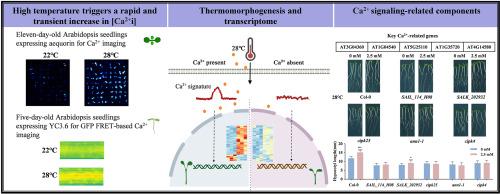Ca2+ signaling is required for high ambient temperature perception in Arabidopsis thaliana
IF 5.7
2区 生物学
Q1 PLANT SCIENCES
引用次数: 0
Abstract
Temperature is a key environmental factor affecting plant growth and development. With the increase in global warming, it is important to understand the signal transduction pathways through which plants perceive and respond to elevated ambient temperature. Calcium (Ca2+) is a second messenger in various environmental stresses in plants. However, the function of Ca2+ in sensing elevated ambient temperature has not yet been well addressed in plants. In this study, using the Ca2+ sensitive aequorin reporter or GFP-based yellow cameleon 3.6 reporter in plants, we show that high temperature treatments transiently increase cytoplasmic Ca2+ concentration in Arabidopsis thaliana. We also found that Ca2+ is required for warm temperature-induced hypocotyl growth. In addition, our RNA-seq data show that transcriptional reprogramming in response to warm temperature is partially dependent on Ca2+. We further identified Ca2+ signaling-related components involved in the decoding of the response to elevated ambient temperature to support our hypothesis. Taken together, our results suggest that plants possess a Ca2+ signaling pathway to sense thermal changes.

Ca2+信号是拟南芥高温感知所必需的
温度是影响植物生长发育的关键环境因子。随着全球变暖的加剧,了解植物感知和响应环境温度升高的信号转导途径非常重要。钙(Ca2+)是植物在各种环境胁迫中的第二信使。然而,Ca2+在植物中感知环境温度升高的功能尚未得到很好的解决。在本研究中,我们利用植物中Ca2+敏感的aequorin报告基因或基于gfp的黄驼龙3.6报告基因,发现高温处理会瞬间增加拟南芥细胞质Ca2+浓度。我们还发现Ca2+对于温暖温度诱导的下胚轴生长是必需的。此外,我们的RNA-seq数据显示,响应温暖温度的转录重编程部分依赖于Ca2+。我们进一步确定了Ca2+信号相关成分参与解码对升高的环境温度的反应,以支持我们的假设。综上所述,我们的研究结果表明植物具有Ca2+信号通路来感知热变化。
本文章由计算机程序翻译,如有差异,请以英文原文为准。
求助全文
约1分钟内获得全文
求助全文
来源期刊
CiteScore
11.10
自引率
3.10%
发文量
410
审稿时长
33 days
期刊介绍:
Plant Physiology and Biochemistry publishes original theoretical, experimental and technical contributions in the various fields of plant physiology (biochemistry, physiology, structure, genetics, plant-microbe interactions, etc.) at diverse levels of integration (molecular, subcellular, cellular, organ, whole plant, environmental). Opinions expressed in the journal are the sole responsibility of the authors and publication does not imply the editors'' agreement.
Manuscripts describing molecular-genetic and/or gene expression data that are not integrated with biochemical analysis and/or actual measurements of plant physiological processes are not suitable for PPB. Also "Omics" studies (transcriptomics, proteomics, metabolomics, etc.) reporting descriptive analysis without an element of functional validation assays, will not be considered. Similarly, applied agronomic or phytochemical studies that generate no new, fundamental insights in plant physiological and/or biochemical processes are not suitable for publication in PPB.
Plant Physiology and Biochemistry publishes several types of articles: Reviews, Papers and Short Papers. Articles for Reviews are either invited by the editor or proposed by the authors for the editor''s prior agreement. Reviews should not exceed 40 typewritten pages and Short Papers no more than approximately 8 typewritten pages. The fundamental character of Plant Physiology and Biochemistry remains that of a journal for original results.

 求助内容:
求助内容: 应助结果提醒方式:
应助结果提醒方式:


